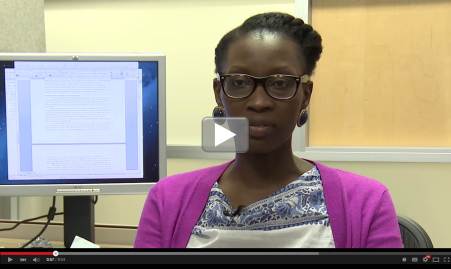LabTV: Curious About the Microbiome
 When people think about the human microbiome—the scientific term for all of the microbes that live in and on our bodies—the focus is often on bacteria. But Keisha Findley, the young researcher featured in today’s LabTV video, is fascinated by a different part of the microbiome: fungi.
When people think about the human microbiome—the scientific term for all of the microbes that live in and on our bodies—the focus is often on bacteria. But Keisha Findley, the young researcher featured in today’s LabTV video, is fascinated by a different part of the microbiome: fungi.While earning her Ph.D. at Duke University, Durham, N.C., Findley zeroed in on Cryptococcus neoformans, a common, single-celled fungus that can lead to life-threatening infections, especially in people with weakened immune systems. Now, as a postdoctoral fellow at NIH’s National Human Genome Research Institute, Bethesda, MD, she is part of an effort to survey all of the fungi, as well as bacteria, that live on healthy human skin. The goal is to get a baseline understanding of these microbial communities and then examine how they differ between healthy people and those with skin conditions such as acne, athlete’s foot, skin ulcers, psoriasis, or eczema.
Findley grew up not too far from NIH, in Takoma Park, MD. Her mother, who is a nurse, encouraged an interest in medicine and in caring for other people. She was also fortunate to have an inspiring science teacher in high school. Findley is following in the footsteps of her mentors by sharing her excitement for science in general, and microbiome research in particular, with students and their parents. “We’re only just beginning and there is so much more to explore,” she tells them.
Findley also wants young people to know that with hard work and persistence, a career in research is within anyone’s grasp. “Don’t let anyone tell you that you can’t do it. I’ve had people in the past tell me that I couldn’t, and I didn’t listen—I just kept moving forward.”
References:
Topographic diversity of fungal and bacterial communities in human skin. Findley K, Oh J, Yang J, Conlan S, Deming C, Meyer JA, Schoenfeld D, Nomicos E, Park M; NIH Intramural Sequencing Center Comparative Sequencing Program, Kong HH, Segre JA. Nature. 2013 Jun 20;498(7454):367-70.
Links:
C. neoformans Infection (Centers for Disease Control and Prevention)
Human Microbiome Project (NIH)
Science Careers (National Institute of General Medical Sciences/NIH)
Careers Blog (Office of Intramural Training/NIH)


































No hay comentarios:
Publicar un comentario